Page 287 of 490
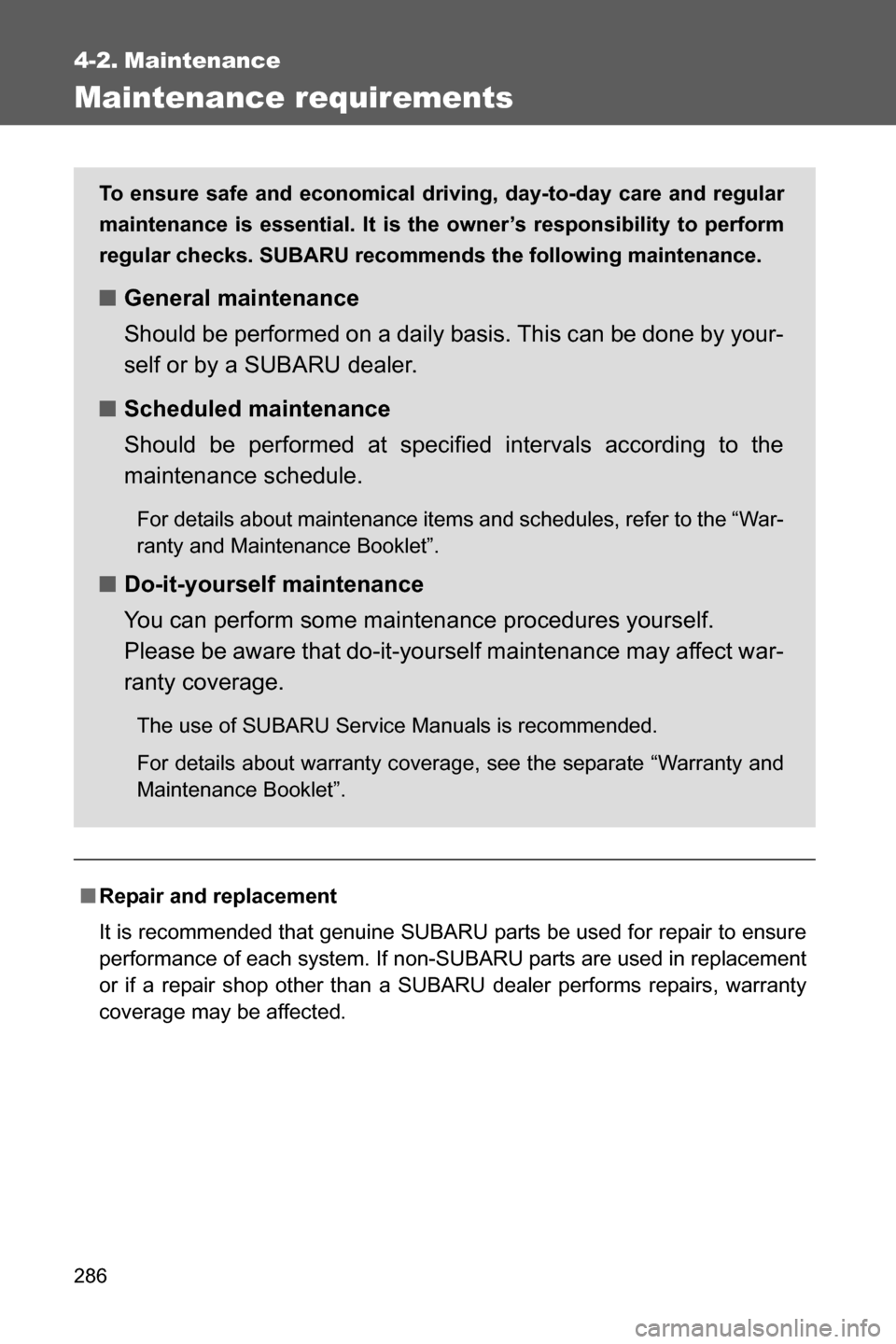
286
4-2. Maintenance
Maintenance requirements
■Repair and replacement
It is recommended that genuine SUBARU parts be used for repair to ensure
performance of each system. If non-SUBARU parts are used in replacement
or if a repair shop other than a SUBARU dealer performs repairs, warranty
coverage may be affected. To ensure safe and economical driving, day-to-day care and regular
maintenance is essential. It is the owner’s responsibility to perform
regular checks. SUBARU recommends the following maintenance.
■General maintenance
Should be performed on a daily basis. This can be done by your-
self or by a SUBARU dealer.
■Scheduled maintenance
Should be performed at specified intervals according to the
maintenance schedule.
For details about maintenance items and schedules, refer to the “War-
ranty and Maintenance Booklet”.
■Do-it-yourself maintenance
You can perform some maintenance procedures yourself.
Please be aware that do-it-yourself maintenance may affect war-
ranty coverage.
The use of SUBARU Service Manuals is recommended.
For details about warranty coverage, see the separate “Warranty and
Maintenance Booklet”.
Page 288 of 490
287 4-2. Maintenance
4
Maintenance and care
■Allow inspection and repairs to be performed by a SUBARU dealer
●SUBARU technicians are well-trained specialists and are kept up to date
with the latest service information. They are well informed about the
operations of all systems on your vehicle.
●Keep a copy of the repair order. It proves that the maintenance that has
been performed is under warranty coverage. If any problem should arise
while your vehicle is under warranty, your SUBARU dealer will promptly
take care of it.
Page 290 of 490
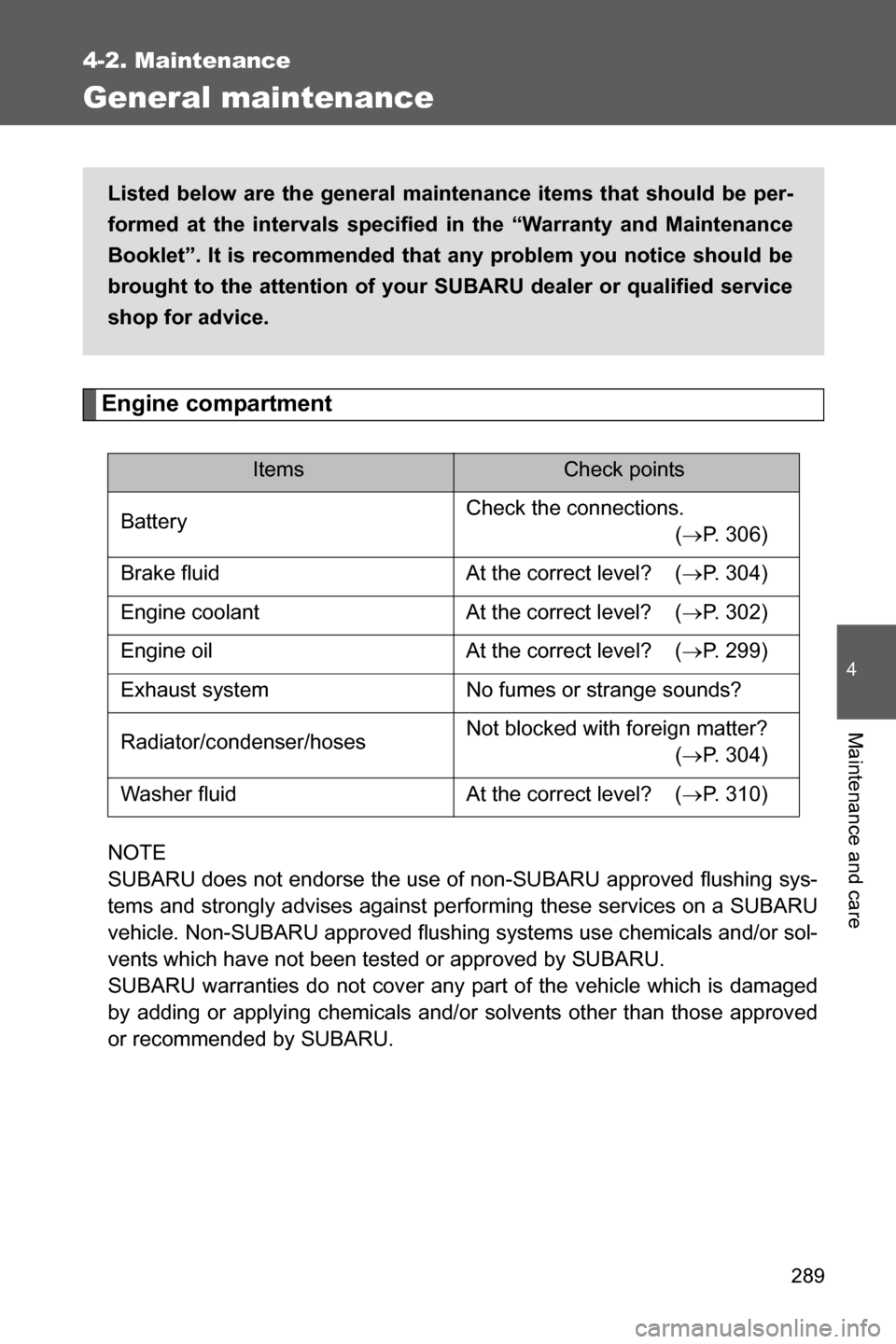
289
4-2. Maintenance
4
Maintenance and care
General maintenance
Engine compartment
NOTE
SUBARU does not endorse the use of non-SUBARU approved flushing sys-
tems and strongly advises against performing these services on a SUBARU
vehicle. Non-SUBARU approved flushing systems use chemicals and/or sol-
vents which have not been tested or approved by SUBARU.
SUBARU warranties do not cover any part of the vehicle which is damaged
by adding or applying chemicals and/or solvents other than those approved
or recommended by SUBARU.
ItemsCheck points
BatteryCheck the connections.
(�oP. 306)
Brake fluid At the correct level? (�oP. 304)
Engine coolant At the correct level? (�oP. 302)
Engine oil At the correct level? (�oP. 299)
Exhaust system No fumes or strange sounds?
Radiator/condenser/hosesNot blocked with foreign matter?
(�oP. 304)
Washer fluid At the correct level? (�oP. 310)
Listed below are the general maintenance items that should be per-
formed at the intervals specified in the “Warranty and Maintenance
Booklet”. It is recommended that any problem you notice should be
brought to the attention of your SUBARU dealer or qualified service
shop for advice.
Page 293 of 490
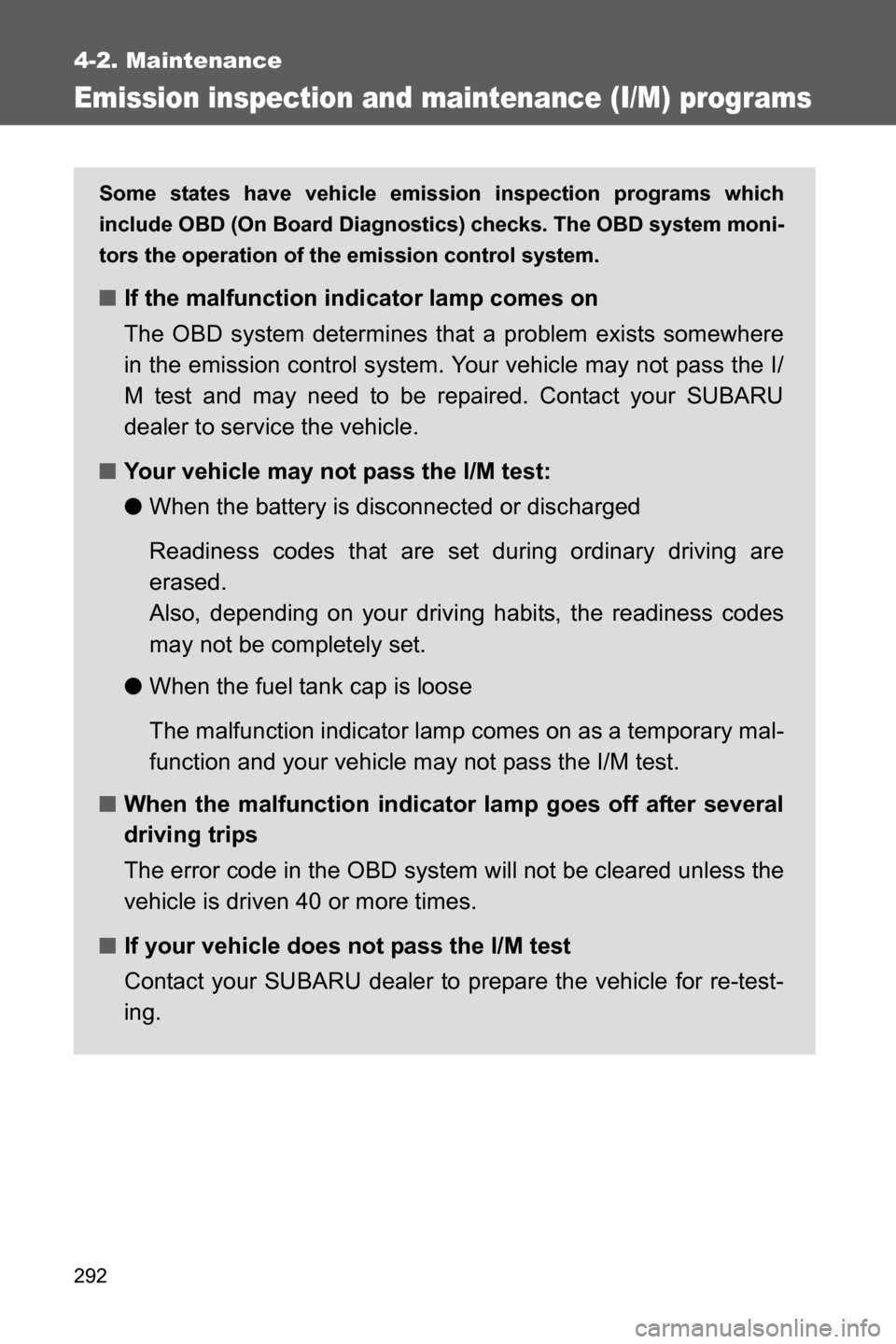
292
4-2. Maintenance
Emission inspection and maintenance (I/M) programs
Some states have vehicle emission inspection programs which
include OBD (On Board Diagnostics) checks. The OBD system moni-
tors the operation of the emission control system.
■If the malfunction indicator lamp comes on
The OBD system determines that a problem exists somewhere
in the emission control system. Your vehicle may not pass the I/
M test and may need to be repaired. Contact your SUBARU
dealer to service the vehicle.
■Your vehicle may not pass the I/M test:
●When the battery is disconnected or discharged
Readiness codes that are set during ordinary driving are
erased.
Also, depending on your driving habits, the readiness codes
may not be completely set.
●When the fuel tank cap is loose
The malfunction indicator lamp comes on as a temporary mal-
function and your vehicle may not pass the I/M test.
■When the malfunction indicator lamp goes off after several
driving trips
The error code in the OBD system will not be cleared unless the
vehicle is driven 40 or more times.
■If your vehicle does not pass the I/M test
Contact your SUBARU dealer to prepare the vehicle for re-test-
ing.
Page 302 of 490
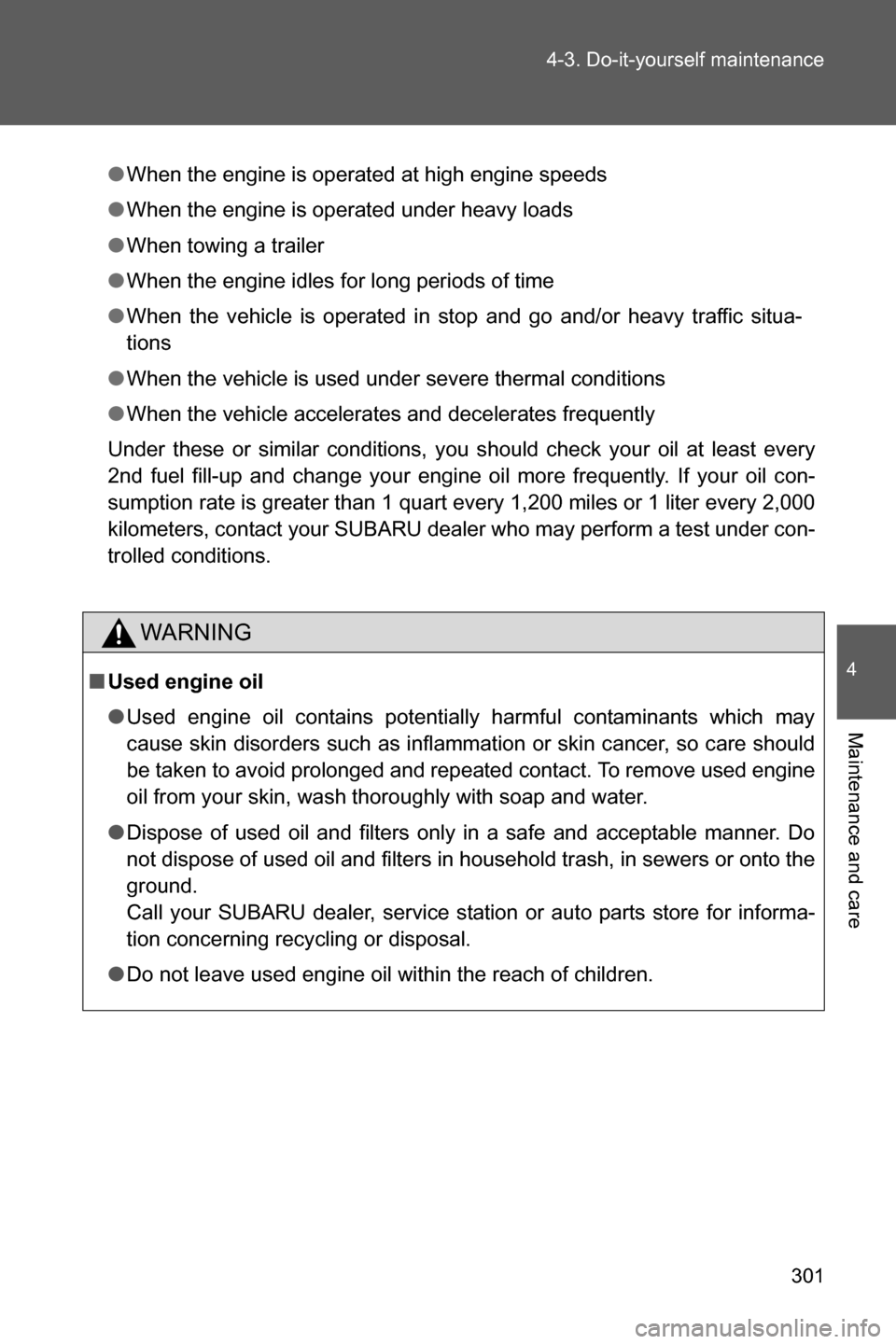
301 4-3. Do-it-yourself maintenance
4
Maintenance and care
●When the engine is operated at high engine speeds
●When the engine is operated under heavy loads
●When towing a trailer
●When the engine idles for long periods of time
●When the vehicle is operated in stop and go and/or heavy traffic situa-
tions
●When the vehicle is used under severe thermal conditions
●When the vehicle accelerates and decelerates frequently
Under these or similar conditions, you should check your oil at least every
2nd fuel fill-up and change your engine oil more frequently. If your oil con-
sumption rate is greater than 1 quart every 1,200 miles or 1 liter every 2,000
kilometers, contact your SUBARU dealer who may perform a test under con-
trolled conditions.
WARNING
■Used engine oil
●Used engine oil contains potentially harmful contaminants which may
cause skin disorders such as inflammation or skin cancer, so care should
be taken to avoid prolonged and repeated contact. To remove used engine
oil from your skin, wash thoroughly with soap and water.
●Dispose of used oil and filters only in a safe and acceptable manner. Do
not dispose of used oil and filters in household trash, in sewers or onto the
ground.
Call your SUBARU dealer, service station or auto parts store for informa-
tion concerning recycling or disposal.
●Do not leave used engine oil within the reach of children.
Page 326 of 490
325 4-3. Do-it-yourself maintenance
4
Maintenance and care
CAUTION
■Replacing tire inflation pressure warning valves and transmitters
(vehicles with a tire pressure monitoring system)
●Because tire repair or replacement may affect the tire pressure warn-
ing valves and transmitters, make sure to have tires serviced by your
SUBARU dealer or other qualified service shop. In addition, make sure
to purchase your tire pressure warning valves and transmitters at your
SUBARU dealer.
●Ensure that only genuine SUBARU wheels are used on your vehicle.
Tire pressure warning valves and transmitters may not work properly
with non-genuine wheels.
Page 360 of 490
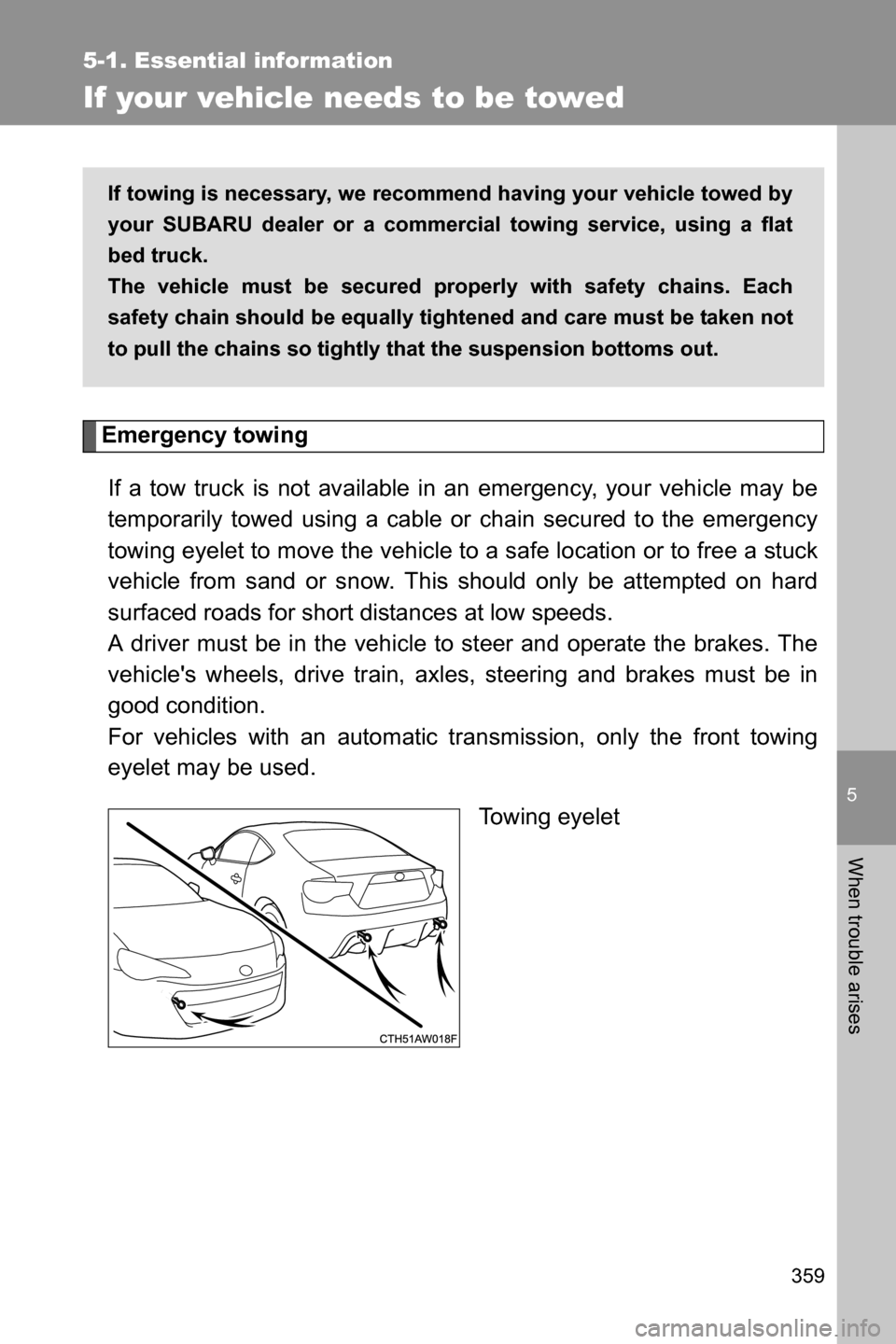
5
When trouble arises
359
5-1. Essential information
If your vehicle needs to be towed
Emergency towing
If a tow truck is not available in an emergency, your vehicle may be
temporarily towed using a cable or chain secured to the emergency
towing eyelet to move the vehicle to a safe location or to free a stuck
vehicle from sand or snow. This should only be attempted on hard
surfaced roads for short distances at low speeds.
A driver must be in the vehicle to steer and operate the brakes. The
vehicle's wheels, drive train, axles, steering and brakes must be in
good condition.
For vehicles with an automatic transmission, only the front towing
eyelet may be used.
Towing eyelet
If towing is necessary, we recommend having your vehicle towed by
your SUBARU dealer or a commercial towing service, using a flat
bed truck.
The vehicle must be secured properly with safety chains. Each
safety chain should be equally tightened and care must be taken not
to pull the chains so tightly that the suspension bottoms out.
Page 393 of 490
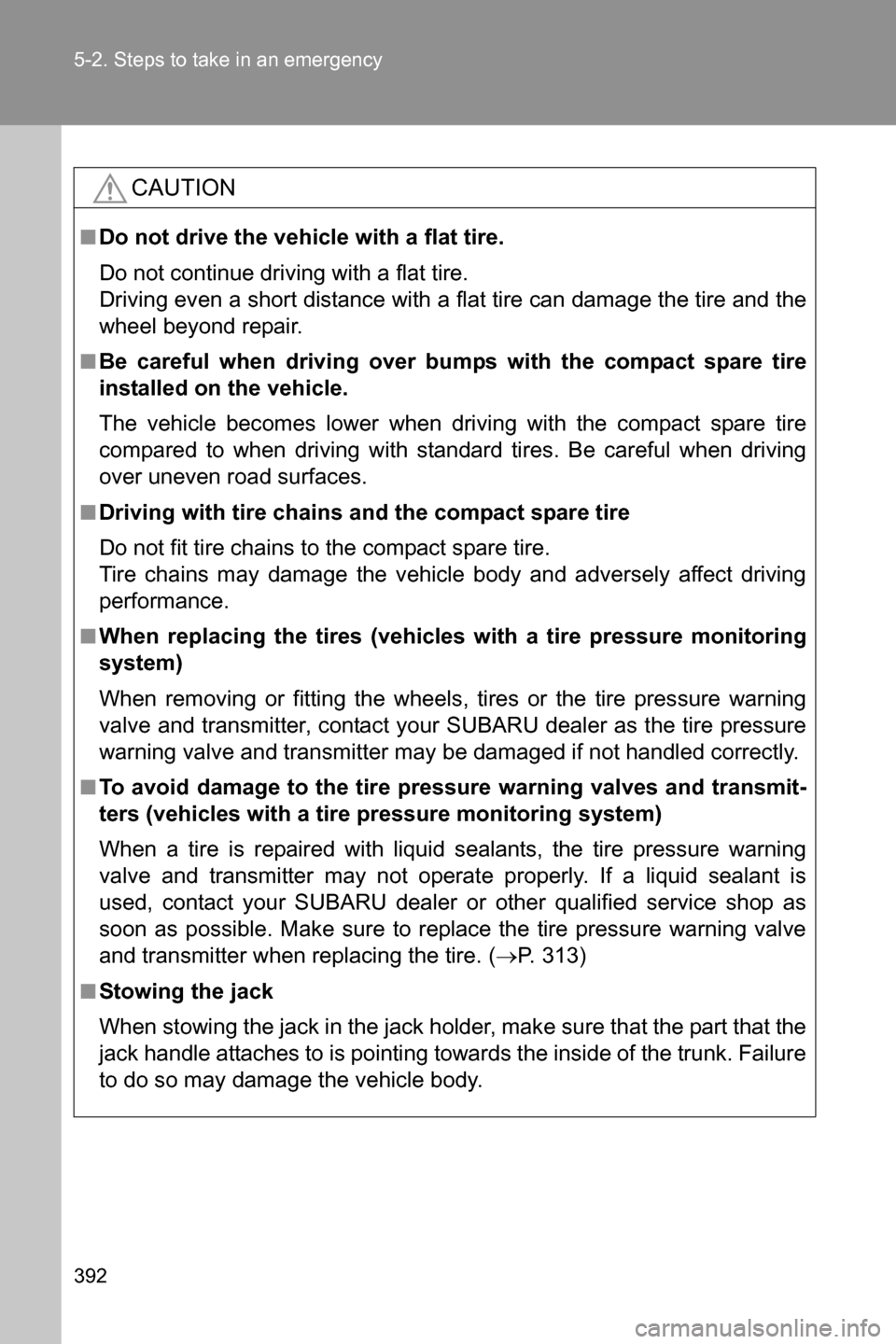
392 5-2. Steps to take in an emergency
CAUTION
■Do not drive the vehicle with a flat tire.
Do not continue driving with a flat tire.
Driving even a short distance with a flat tire can damage the tire and the
wheel beyond repair.
■Be careful when driving over bumps with the compact spare tire
installed on the vehicle.
The vehicle becomes lower when driving with the compact spare tire
compared to when driving with standard tires. Be careful when driving
over uneven road surfaces.
■Driving with tire chains and the compact spare tire
Do not fit tire chains to the compact spare tire.
Tire chains may damage the vehicle body and adversely affect driving
performance.
■When replacing the tires (vehicles with a tire pressure monitoring
system)
When removing or fitting the wheels, tires or the tire pressure warning
valve and transmitter, contact your SUBARU dealer as the tire pressure
warning valve and transmitter may be damaged if not handled correctly.
■To avoid damage to the tire pressure warning valves and transmit-
ters (vehicles with a tire pressure monitoring system)
When a tire is repaired with liquid sealants, the tire pressure warning
valve and transmitter may not operate properly. If a liquid sealant is
used, contact your SUBARU dealer or other qualified service shop as
soon as possible. Make sure to replace the tire pressure warning valve
and transmitter when replacing the tire. (�oP. 313)
■Stowing the jack
When stowing the jack in the jack holder, make sure that the part that the
jack handle attaches to is pointing towards the inside of the trunk. Failure
to do so may damage the vehicle body.